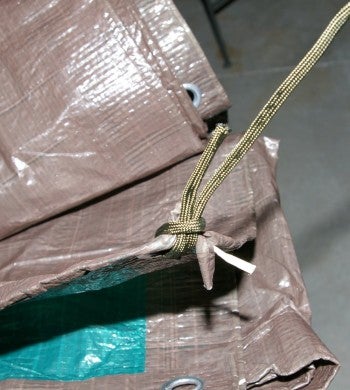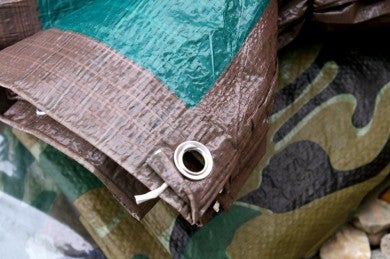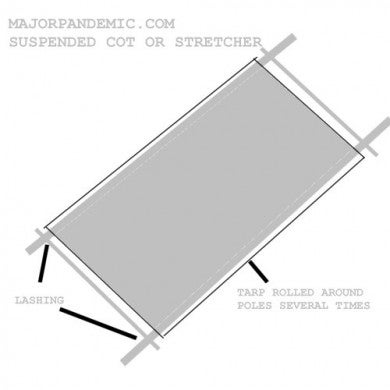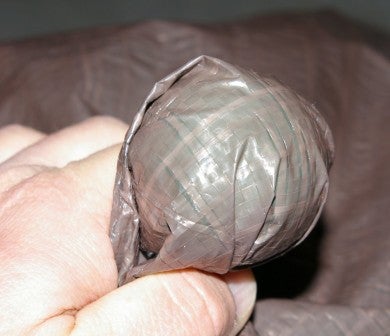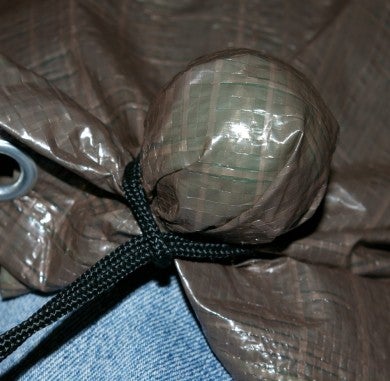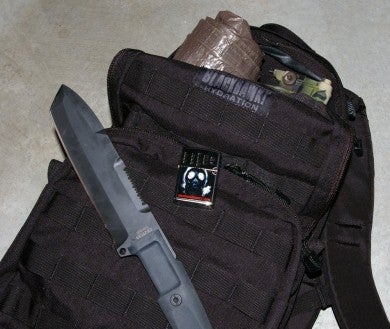The Wonderful, Terrific Tarp
Major Pandemic 02.25.14

MMMMmmm, tarps. Yeah I know what you’re thinking, but these handy little tools are likely to save your butt more than that sexy $2,000 AR will any day of the week. A good tarp can keep you dry, block the wind and sun, help collect water, be used as an improvised sail, provide camouflage, and act as a barrier for insects and moisture. Tarps also allow for an array of improvised carry methods for supplies, food, and wounded buddies, and they protect you and your equipment from the elements. In all, a tarp is an indispensable necessity if you don’t want to miserable when the weather turns. It is another duct tape/Leatherman level of utility that you should never be without. Even in my 24 hour “get home” bag, I have a small tarp.
My well-used tarps were in need of replacement, so I picked up several sizes of tarps from Foremost Tarp company. You can go tiny or gigantic, but the sizes I purchased were tarps in 8’x10’ and 12’x16’ camouflage and a 5’x7 green/brown reversible tarp.
Foremost Tarp has been in business for over 30 years and is one of the oldest tarp manufacturers in the US. The company is a US based supplier and OEM manufacturer to many of the major retail chains’ tarps you see on the shelves. Foremost Tarp has developed a reputation as the most trusted name in tarps and can be found on the shelves of many hardware and farm stores across the US and Canada.
As you can probably imagine, most tarp companies are located overseas, but Foremost has found that their attention to quality, consistency, and US service is what brings their large retailers coming back year after year. Like nearly every tarp these days, Foremost utilizes overseas manufacturing, but insists on quality screening and random testing to assure final production is up to their design specifications.
The Truth About Tarps
There is an untrue assumption that you can tell the quality of a tarp by its color. One manufacturer did market their tarps in that manner decades ago, but today you should not shop under the assumption that the color of the tarp equals quality. Instead, look at a few other aspects like material weight and overall construction.
Foremost has the features you should look for in a basic tarp, including grommets every 36” and durability enhancements such as rope reinforced hems, 10×6 weave, and strong 2.9oz per square yard weight.
Extra grommets allow more versatility and distribute the tension and stress points across the tarp. Contrast this to other typical tarps that only have grommets at each corner. This mean that your tarp will last longer and likely tear out less. The 10×6 weave and material weight are signs of high quality that inexpensive tarps will not match up to. The 2.5oz/sq yard weight is critical if you ever intend on using the tarp to carry weight. A tarp above the 2.5oz/sq yard weight with a internal weave will generally support the weight of an average 200lb man if you use it for a makeshift cot, stretcher, or hammock, but the heavier the material the better. Foremost’s waterproof rip-stop material is a great compromise between durability and weight.
A note of caution and education: typical tarps are sized by their “cut size” vs. their “finished/final size.” Some tarps may note both. Cut size is usually about four feet less of width and length than stated, so a 16’x20’ Cut Size tarp will be a finished size of 12’x16’. Plan accordingly, or you may come up short when attempting to find the right tarp size.
Tarp Use
Most people think a tarp is only good for draping over your lawn mower that you leave outside, but with a little ingenuity, the lowly tarp can provide so much more in a survival or everyday outdoor situation.
After searching the Internet for a hour for some decent tarp use diagrams, I decided to create and share my own crude versions of various ways to use a tarp. Please excuse the quality of the artwork, but hopefully you get the idea.
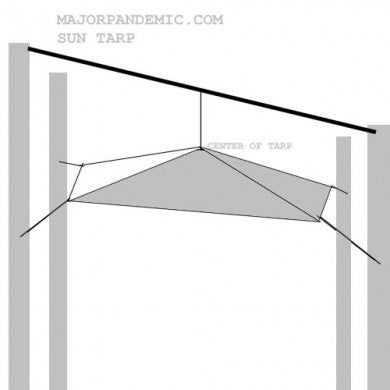
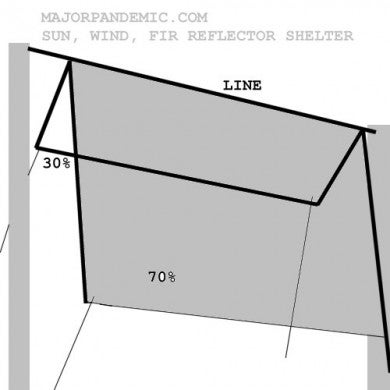
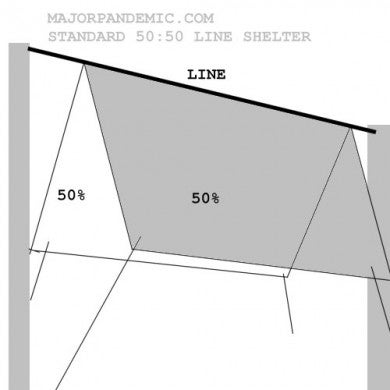
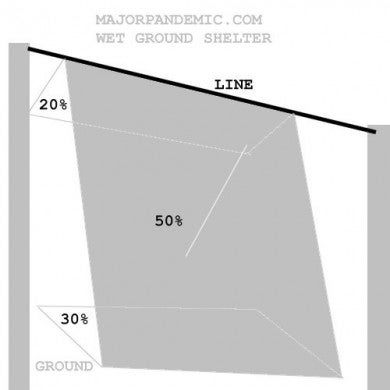
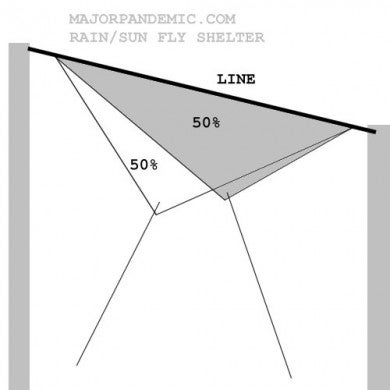
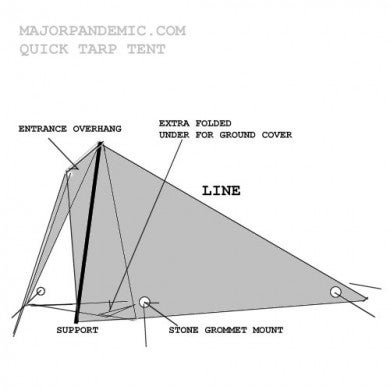
Get creative, and think about unique ways to use a tarp for all manner of sun, wind, rain, snow, and heat retention. Obviously, even cotton, non-synthetic tarps can be used with caution around fire without melting.
Some great ideas are to use a golf ball or smooth rock as a heavy duty lashing point anywhere on the tarp, including the dead center. This method delivers a lot of strength while minimizing tearing a hole in your tarp. It also allows a larger tarp to be used as a 360 tee-pee type shelter with only a single suspension line and a few stakes. Get creative.
Final Thoughts
I have found that a simple little camo tarp turns a potentially miserable outdoor trip due to sun and rain into something totally bearable and potentially fun and enjoyable. Generally, the cost of this little luxury is less than $30 in a smaller daypack or 24-hour pack size, and which isn’t much for something that could be a critical, life saving, survival accessory.
Everyone should have a couple tarps and a few rolls of sheet plastic, as both come in extraordinarily handy in everyday life. The sizes I recommend are 8’x10’, 12’x16’, and and 5’x7’ in your choice of color. The 5×7 is small enough that is can be stuffed into a small 24 hour bug out bag like this 830cu/in Blackhawk S.T.R.I.K.E. Predator hydration pack.
The 8’x10’ is a good two person size, which offers a lot of options for 72 hour camping and bug out packs. Also, 12’x16’ is a size that can provide large coverage for a family, but will most likely be something carried in a car due to the weight. All you need is a 50’ pack of paracord from Paracord.com and you can create some handy shelters and useful devices. That pretty AR won’t keep you warm, dry, or out of the sun, so I would suggest picking up a quality tarp on your next visit to the hardware store. And if you buy a good one, then chances are it will be from Foremost Tarp.
Specs
- 10×6 Weave
- 2.9oz/sq. yrd
- Grommets every 36”
- Rope reinforced hem
- MSRP $15.99-$29.99 as tested.
